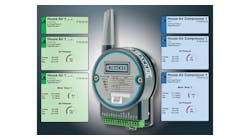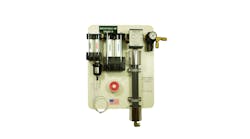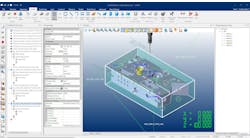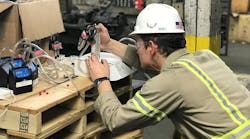By now every metalcaster should be aware that federal regulators are deeply invested in environmental health and safety conditions in their operations. After decades of consideration and discussion, in March 2016 the U.S. Occupational Health and Safety Administration (OSHA) issued its final rule to minimize workers’ exposure to respirable crystalline silica — which, the agency holds, may cause lung cancer, silicosis, chronic obstructive pulmonary disease and kidney disease in workers.
That rule has been in effect since June 2016, but not all the rule’s components have been fully enforced. That will end this month. As of June 23, 2018, manufacturers will be required to comply fully with the OSHA General Industry Respirable Crystalline Silica Rule. With that deadline approaching, it is incumbent upon foundries and other employers affected by the rule, to carefully assess their compliance efforts.
In a previous report, I described the Keramida process for real-time mapping of relative silica loading within a facility. This important evaluation method assists foundries in determining where to focus efforts at silica reduction. This process is much more effective in identifying where and how to spend resources than traditional employee sampling.
Given that the OSHA standard requires all feasible engineering controls to be implemented, Keramida recommends following mapping with a comprehensive audit to identify source-reduction opportunities. It’s likely that many of these opportunities will be executed through engineering controls, and an effective auditor will have significant experience in identifying and implementing engineering controls solutions in other foundries or related industries.
However, the mapping and audit are only initial steps to complying with one part of a multi-faceted standard. Once the map and audit have been completed, next steps should be considered, including employee-exposure sampling, documentation, and the required, written silica exposure control plan. Let’s begin with a closer study of employee exposure sampling.
As explained previously, employee-sampling data is not an effective tool for identifying respirable crystalline silica sources within a plant, nor is it recommended prior to implementing feasible engineering controls. However, the standard requires employers to evaluate employee exposures in a manner that accounts for all employees within the facility. So, once the plant has implemented its short-term engineering solutions, the next critical step is to determine the employee-exposure levels.
While the standard allows several methodologies for this evaluation, our experience indicates that in most cases a simple approach is best.
Prior to beginning the sampling, it is important to understand that the standard requires an employer to determine the exposure levels for every employee. This does not necessarily mean that every employee must be sampled, but rather that the sampling regimen must account for every employee.
On this point, many employers and their industrial hygienists fall short. The vast majority of industrial hygiene sampling reports we review do not include a sampling plan. In order to prove compliance to the standard, a sampling plan should be developed prior to conducting any sampling. This step is the most important part of the process and, again, the most frequently omitted aspect of the compliance effort.
This plan will identify who is to be sampled, where he/she spends most of his/her time, his/her job description or title, and most important, the justification for identifying the selected individuals as representative of all employees within the facility.
The person preparing the sampling plan must have a thorough knowledge of industrial hygiene air-sampling methodologies, respirable crystalline silica behavior when airborne, specific characteristics of the industry being sampled, and the pertinent OSHA requirements. Many employers, and unfortunately many industrial hygienists, simply do not have the breadth of knowledge and experience to develop an efficient, effective. and accurate sampling plan for respirable crystalline silica.
Once the sampling plan has been developed and approved by the plant’s operations, engineering, environmental, and safety teams, as well as the industrial hygienist, a sampling protocol should be selected. At this point it is important to note that the industrial hygienist should specify the appropriate sampling and analysis protocols, some of which are specifically referenced by the standard. The sampling techniques should incorporate appropriate quality control methods and the samples should be analyzed by a laboratory that follows the analysis methodologies specified in the standard.
The most common mistake that we observe during this step is plants’ failure to adhere precisely to the protocol. Some examples of this include failure to place the sampling inlet in the employees’ specified breathing zone; turning “cyclones” upside down at completion of the sampling event; the industrial hygienist’s failure to regularly monitor the sample pumps throughout the event; failure to correctly calibrate air pumps; and failure to accurately record durations.
The new OSHA standard requires an initial employee-exposure assessment followed by subsequent assessments completed at intervals based upon initial exposure levels, or when conditions change. A common example of changing conditions is simply the season of the year: Many plants operate with exterior doors open during warm months, and with the doors closed during cool months. Any subsequent sampling plan should include a list of employees, areas, or job descriptions that were omitted based upon lack of silica exposure above the Action Limit of 25 µg/m³.
While the OSHA standard specifies the requirements for sampling and analysis, it does not specify who may conduct the sampling. There are myriad resources and experiences available for this: some employers have in-house industrial hygienists who conduct regular employee exposure sampling; others have never conducted exposure sampling at their facilities.
Regardless of the capabilities of the employer, we recommend appointing a professional industrial hygienist with experience in compliance to the new silica standard to conduct the initial exposure sampling. Once the initial sampling has been completed, an employer may consider utilizing existing qualified employees, or training employees, to conduct subsequent sampling.
Should an employer conduct this sampling in-house, it is recommended that outside resources be utilized periodically. Many employers ask why they should use an outside resource when they have employees capable of doing this work? There are two reasons.
First, especially for initial sampling, it is extremely important that the sampling plan is properly developed and the protocol is established and followed. An experienced outside resource ensures compliance, and can be an effective way to verify quality and precision.
The second reason is that, in the event of litigation or dispute, an independent and unbiased source may be more effective at presenting the employer’s case. Sampling for respirable crystalline silica is not difficult, but it must be precise. Consider training in-house resources to do this task, if ongoing sampling is required. However, verifying that data periodically and regularly with a qualified professional sampling event provides great benefit to the employer.
The long-anticipated enforcement date is upon us. Are you prepared? Have you identified your silica sources through mapping or a similar assessment? Have you implemented a plan for source reduction through a comprehensive audit? Have you conducted initial employee exposure sampling in a manner that is compliant with the standard? Are you documenting every step and including this information in your silica exposure control plan?
The next installment of this series will address common mistakes in implementing engineering controls and documentation requirements, specifically the recommended contents of a Silica Exposure Control Plan.
Trent Blake is the director of Security, Health and Safety Services for Keramida Inc., which engineers and develops global EHS and sustainability programs. Contact him at [email protected]









